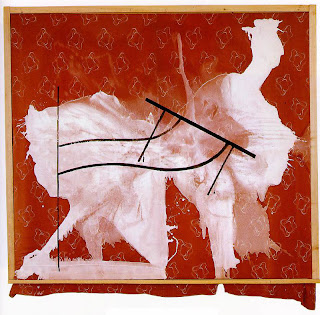 fetish-
fetish--an inanimate object worshipped for its supposed magical powers or because it is considered to be inhabited by a spirit
-a course of action to which one has an excessive and irrational commitment
- a form of sexual desire in which gratification is linked to an abnormal degree to a particular object, item of clothing, part of the body, etc…
(www.encyclopedia.com)Tables Turning Sigmar Polke (1981)
n the 1970s, in his farmhouse near Dusseldorf, Polke experimented with photographic dark-room techniques, deliberately ignoring the standard rules: ‘dropping the wrong chemicals onto the paper, turning on the light during development, brushing the developer on selectively, using exhausted fixer’.6 The ‘mistakes’ turned into inventive techniques: for example, he started to fold the paper during development because the trays were too small for larger prints, but the welcome effect was that the image became obscured by blossoming chemical stains along the folds. This fitted well with Polke’s psychedelic exuberance and interest in spatial juxtaposition (the flat, folded paper producing the other-worldly clouds), but it also harked back to the early days of photography, revisiting a time when the new technology was considered a medium in more than one sense – as a means to summon ghosts. Exposing surfaces to experimental mixtures of substances and light fed into Polke’s painting, further fuelled by his ambitious research into ancient and new pigments and paint during trips to Australia and South-east Asia; just in time for the return of painting in the ’80s.
Made on the back of all this, Tischerücken (Table Turning, 1981) has been described as a breakthrough painting, although it actually exemplifies several kinds of literal and metaphorical breakthroughs. There is the brownish-red furnishing fabric, which acts as the ‘canvas’ and slips through the lower end of the dark wooden frame it is stretched on like a fastened tablecloth (which, with its repetitive pattern of a gently curved and closed form, it could well be). The lower horizontal bar of the frame, however, is mounted in such a manner that it juts out from the wall as though it was a windowsill with a curtain stuck under it, letting the painting flip between the table and window association, between object and image. This movement is reflected by a large irregular puddle of white paint spilled on the cloth, apparently applied when the painting was horizontal, so that the oozing of the paint could be controlled by jacking its sides up or down; it is also reflected by the fact that on top of this puddle there is the black outline of a ‘flying’ table.
The tables in this work are, of course, those used for a séance, and the white spills directly reminiscent of ectoplasm.7 Yet the séance table was also Karl Marx’s oft-cited metaphor for the strange machinations of commodity fetishism: for as soon as an ordinary wooden table ‘steps forth as a commodity, it is changed into something transcendent. It not only stands with its feet on the ground, but, in relation to all other commodities, it stands on its head, and evolves out of its wooden brain grotesque ideas, far more wonderful than “table-turning” ever was.’8 Polke – pointedly at a time when painting resurged as a particularly sought-after commodity – seemed to juggle these different levels of meaning at once, while making sure that none of them became too securely fixed.
Frieze Issue 110 October 2007 by Jorg Heiser


No comments:
Post a Comment